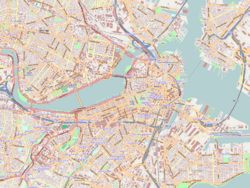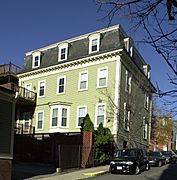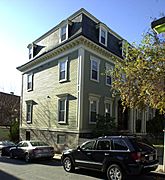Francis B. Austin House facts for kids
Quick facts for kids |
|
|
Francis B. Austin House
|
|
 |
|
| Location | 58 High St., Boston, Massachusetts 02129 |
|---|---|
| Area | less than one acre |
| Built | 1832 |
| Architectural style | Second Empire |
| NRHP reference No. | 87001478 |
| Added to NRHP | October 21, 1988 |
The Francis B. Austin House is a special old house located at 58 High Street in the Charlestown neighborhood of Boston, Massachusetts. It was built around 1832 and then got a big makeover in the 1860s. This house is a great example of a building style called Second Empire architecture.
The Austin family, who built the house, were important people in the area. They owned a lot of land and ran businesses. In the 1900s, the house was changed into a building with several apartments. It was added to the National Register of Historic Places in 1988, which means it's an important historical site.
Contents
About the Francis B. Austin House
The Francis B. Austin House stands in a busy neighborhood in Charlestown. It's on the corner of High and Wood Streets, not far from Monument Square.
What Does the House Look Like?
This house is a two-and-a-half story building made of wood. It has a special roof called a mansard roof, which has sloped sides and creates extra space for rooms upstairs. A part of the house sticks out at the back, which is two stories tall with a pointed roof. The house sits on a strong stone foundation.
The front of the house has five sections with windows. These windows have decorative frames around them. The mansard roof has three windows sticking out of it, and they have rounded tops. The main front door is in the middle. It has a small porch with two square pillars that make it look grand. The inside of the house has been changed a lot over the years.
Who Lived Here?
The house was built around 1832 by William Austin. He was an important person in Charlestown who owned a lot of land. At first, it was a duplex, meaning it was split into two homes. William Austin lived in one part, and a ship's captain lived in the other. William Austin also helped make laws for Charlestown in the state government.
After William Austin passed away in 1841, his son, Francis Austin, made big changes to the house around 1865. He added the mansard roof and gave it the fancy Second Empire look we see today. Francis Austin was a local merchant. He sold large amounts of fabric and other goods, and also worked with iron and steel. For much of the 1900s, the house was used as a rooming house, where people rented single rooms. Later, it was turned into apartments.
Gallery
See also
 In Spanish: Francis B. Austin House para niños
In Spanish: Francis B. Austin House para niños






